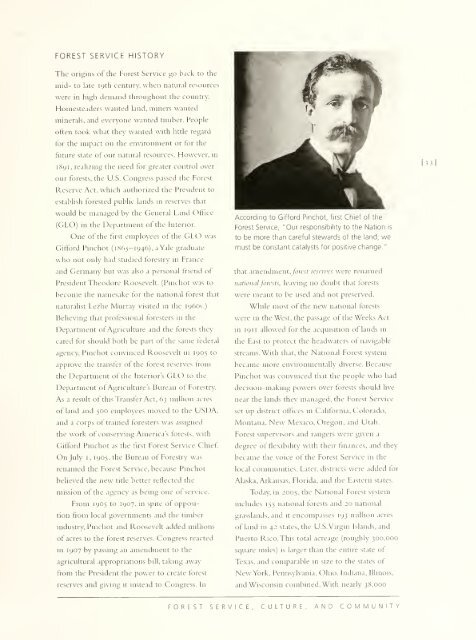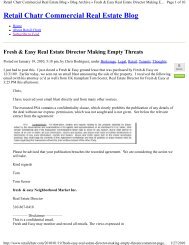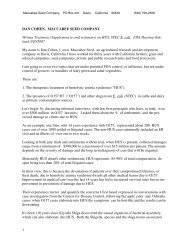—3 3]OCCUPATIONAL CULTUREThe 2005 <strong>Smithsonian</strong> Folklife Festival programForest Service,Culture, and Community presentsoccupational traditions from the USDAForest Service, an organization celebratingits centennial, as well as other forest-dependenttraditions from the cultural communitiesit serves. Approximately too participantsare on the National Mall to share their skills,experiences, and traditions with membersof" the public; they include tree pathologists,wildlife biologists, landscape architects,historic horticulturalists, botanists, bird banders,archaeologists, environmental engineers, firefighters,smokejumpers. recreation specialists,backcountrv rangers, wooden vers, basketmakers, quilters, instrument makers, musicians,poets, storytellers, and camp cooks.Forest Service,Culture, and Community buildsupon previous Folklife Festival programs thathave examined occupational traditions, suchas American Trial Lawyers in [986, Wliite HouseWorkers in 1992, Working ¡11 the <strong>Smithsonian</strong> in[996, and Masters oj the Building Arts in 2001.Every occupational group including cowboys,factor) workers, farmers, firefighters, loggers,miners, oil workers, railroaders, security officers,even students and teachers—has itsowntraditions, which may have a variety of forms.One such form is the use oí a specializedvocabulary. For instance, city doctorsmay refer to malingering hospital patientsKennebec River in central Maine; pranks andjokes, which are often directed at the newestrookie; stones and personal remembrancesntwork incidents or characters; and a wideassortment ot customs and superstitions. Whattolklonsts at the <strong>Smithsonian</strong> try to understand,as they identify and ask questions aboutdifferent occupational traditions, are the skills,specialized knowledge, and codes of behaviorthat distinguish a particular occupationalgroup and meet its needs as a community.Another way ot looking at occupationalculture is to see it as a part ot a particularcompany, agency, or organization. As [amesQ. Wilson observes, "Every organization hasa culture, that is, a persistent, patterned wayof thinking about the central tasks of andhuman relationships within an organization.Culture is to an organization what personalityis to an individual. Like human culturegenerally, it is passed on from one generationto the next. It changes slowly, if at all."The tooth anniversary of the USDA ForestService in 2005 provides a splendid opportunityfor understanding and appreciating itsorganizational and occupational cultures.The occupational culture of theUSDA Fotest Service is representedby a diverse group of workers.as gomers,perhaps an acronym for "(let Outot My Emergency Room"; loggers intheNorthwest refer to blackberry ¡am as beatsignand hotcakes as saddle blankets; and academicsrefer to then' doctoral degree astheir union card,and books as tools of the trade, as if to suggestthat their ivory-tower realm has the same rigorand robust organization asthe factory floor.Inother cases, occupational traditions takethe form of specialized tools, gear, and clothingworn by members ot the occupational group;ballads and folk songs, such as "The [am onGerry's Rock," which tells oi a tragic accidentthatoccurred when floating logs jammed on theSMITHSONIAN FOLKLIFE FESTIVAL
FOREST SERVICE HISTORYThe origins of the Forest Service go back to themid- to late 19th century, when natural resourceswere in high demand throughout the country.Homesteaders wanted land, miners wantedminerals, and everyone wanted timber. Peopleoften took what they wanted with little regardfor the impact on the environment or for thefuture state of our natural resources. However, in1891, realizing the need tor greater control over3 3our forests, the U.S. Congress passed the ForestReserve Act, which authorized the President toestablish forested public lands in reserves thatwould be managed by the General Land Office(GLO) in the Department of the Interior.One of the first employees of the GLO wasGifford Pinchot (1865— 194.6), a Yale graduatewho not only had studied forestry inFranceand Germany but was also a personal friend ofPresident Theodore Roosevelt. (Pinchot was tobecome the namesake for the national forest that[960s.)Believing that professional foresters in thenaturalist Lezlie Murray visited in theDepartment of Agriculture and the forests theycared for should both be part of the same federalagency, Pinchot convinced Roosevelt in 1905 toapprove the transfer of the forest reserves fromthe Department of the Interior's GLO to theDepartment of Agriculture's Bureau of Forestry.As a result of this Transfer Act, 63 million acresof land and 500 employees moved to the USDA,and a corps of trained foresters was assignedthe work of conserving America's forests, withGifford Pinchot as the first Forest Service Chief.On July 1, [905, the Bureau of Forestry wasrenamed the Forest Service, because Pinchotbelieved the new title better reflected themission of the agency as being one of service.From 1905 to 1907, in spite of oppositionfrom local governments and the timberindustry, Pinchot and Roosevelt added millionsof acres to the forest reserves. Congress reactedin1907 by passing an amendment to theagricultural appropriations bill, taking awayfrom the President the power to create forestreserves and giving it instead to Congress. InAccording to Gifford Pinchot, first Chief of theForest Service,"Our responsibility to the Nation isto be more than careful stewards of the land; wemust be constant catalysts for positive change."that amendment, forest reserves were renamednational forests,leaving no doubt that forestswere meant to be used and not preserved.While most of the new national forestswere in the West, the passage of the Weeks Act111 1911 allowed for the acquisition of lands inthe East to protect the headwaters of navigablestreams. With that, the National Forest systembecame more environmentally diverse. BecausePinchot was convinced that the people who haddecision-making powers over forests should livenear the lands they managed, the Forest Serviceset up district offices 111 California, Colorado,Montana, New Mexico, Oregon, and Utah.Forest supervisors and rangers were given adegree of flexibility with their finances, and theybecame the voice of the Forest Service in thelocal communities. Later, districts were added torAlaska, Arkansas, Florida, and the Eastern states.Today, in 2005, the National Forest systemincludes isS national forests and 20 nationalgrasslands, and it encompasses 193 million acresof land m 42 states, the U.S. Virgin Islands, andPuerto Rico. This total acreage (roughly 300,000square miles) is larger than the entire state ofTexas, and comparable in size to the states ofNew York, Pennsylvania, Ohio. Indiana, Illinois,and Wisconsin combined. With nearly 38,000FOREST SERVICE, CULTURE, AND COMMUNITY
- Page 1: Smithsonianolklife Festival\Food Cu
- Page 4 and 5: The annual Smithsonian Folklite Fes
- Page 7 and 8: —CONTENTSThe Festival's Timely Ap
- Page 9 and 10: —THE FESTIVAL'S TIMELY APPEALLAWR
- Page 11 and 12: COMMERCE FOR CULTUREFrom the Festiv
- Page 13 and 14: [ii]The food concession for the Mel
- Page 15 and 16: oMiiitbioni.indotal SoundL04.A 1 Sl
- Page 17: 1WELCOME TO THE 2005 FOLKLIFE FESTI
- Page 20 and 21: Workers harvest artichokes at Ocean
- Page 22 and 23: —assigned aparticular dish—meat
- Page 24 and 25: I--IPot Pie Farm manager Elizabeth
- Page 26 and 27: ISustainable farmers such as Eliot
- Page 28 and 29: "IThe numberof programsdesignedfor
- Page 30 and 31: .hadSALAD GREENS WITH GOAT CHEESE,
- Page 32 and 33: w.A>wm:~
- Page 36 and 37: employees, the USDA Forest Servicei
- Page 38 and 39: I[3 6]page book, which could fit in
- Page 40 and 41: ká.!i- .>!mKPA backpacker sets up
- Page 42 and 43: --^i'liunterw eight jihI ...itl jib
- Page 44 and 45: —4-"The essentialpiece isto captu
- Page 46 and 47: I44cutDUTCH OVENONE-POT MEALThomas
- Page 48 and 49: —FUTURE CONCERNS FOR PUBLIC LANDS
- Page 50 and 51: NUESTRA MÚSICA: MUSIC INBuilding C
- Page 52 and 53: plena groups throughout the Northea
- Page 54 and 55: NUESTRA MÚSICA LAUNCHES NEW SERIES
- Page 56 and 57: NUESTRA MÚSICA: MUSIC IN LATINO CU
- Page 58 and 59: "ILos Camperos de Valles son músic
- Page 60 and 61: RAICES LATINASNUESTRA MÚSICA LANZA
- Page 63 and 64: IOMAN: DESERT, OASIS, AND SEARICHAR
- Page 65 and 66: DESERTThe deserts ot the Arabian Pe
- Page 67 and 68: THE FESTIVAL PROGRAMThe 200s Smiths
- Page 70 and 71: 6 8The coiled, leather-covered bask
- Page 72 and 73: 70]COASTAL CRAFTSMANSHIPAND GLOBAL
- Page 74 and 75: [72]Although the oldismaking way fo
- Page 76 and 77: AN OMANI FOLKTALEASYAH AL-BUALYOman
- Page 79 and 80: y%aMUSIC AND DANCE INOMANOMAN CENTR
- Page 81: In the southern Dhufar region, al-b
- Page 84 and 85:
ecosystems, identification of plant
- Page 86 and 87:
2:00IIIVorkshopFESTIVAL SCHEDULE (P
- Page 88 and 89:
Rhythm,Saturday, June 25 (Programs
- Page 90 and 91:
)avidi nestMonday, June 27(Programs
- Page 92 and 93:
1:00IIlamFriday, July 1 (Programs a
- Page 94 and 95:
)utchSunday, July 3(Programs are su
- Page 96 and 97:
EVENING CONCERTSSounds of the Fores
- Page 98 and 99:
theRELATED EVENTS[96]Nuestra Músic
- Page 100 and 101:
IIDónalas Anderson,Washington, D.C
- Page 102 and 103:
'IEd LiíDmi, Studio City, Californ
- Page 104 and 105:
ISudhir Seth, Bethesda, MarylandA g
- Page 106 and 107:
1 if 1 DumberHoneyBeehive Beeproduc
- Page 108 and 109:
1"''NewI >onI Lui\IDon Bustos,Espa
- Page 110 and 111:
Ian Barlow, White Bird,Idaho; Woodl
- Page 112 and 113:
I 'istnet1Gordon Grant,Corvallis, O
- Page 114 and 115:
Kristen Marline, Flagstaff,Arizona;
- Page 116 and 117:
I1 ountries,IIHistorie Site, once t
- Page 118 and 119:
1IworksI1 11Istations are vital to
- Page 120 and 121:
1'IenIpanderetas;JCJ Band. Washingt
- Page 122 and 123:
Ralph Rinzlersongs are "made" (or c
- Page 124 and 125:
I >cmseI VhorahII MiI lameEne Nance
- Page 126 and 127:
|i 2forIIBartlevy1 )oerr;IIParadeSP
- Page 128 and 129:
II AerialIIII1Washington and Jeffer
- Page 130 and 131:
Stack, Bill Stafford, loni Stafford
- Page 132 and 133:
SMITHSONIAN FOLKLIFE FESTIVAL 20051
- Page 135 and 136:
SMITHSONIAN FOLKLIFE FESTIVAL 2005B
- Page 138:
Smithsonian Folklife FestivalSMITHS








